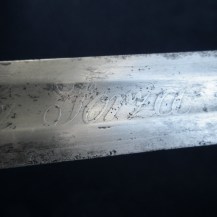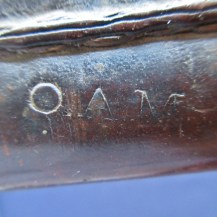Italian Circa 1848 Piedmontese Short Sword, Italian War of Independence with Risorgimento Inscription
Straight, double-edged, spear pointed blade with shallow central fuller. Cast brass hilt with acorn shaped finials and central cross motif on one side, ribbed brass grip, round pommel. Black leather scabbard with brass pieces at the chape and throat, heart-shaped frog stud.
The scabbard is faintly stamped ‘OAM’.
The blade is etched on one side with foliate motifs and the dedication ‘Valore Lombardo 22 Marzo 1848’ and on the other ‘Nell’Unione La Forza’. I believe this translates to ‘Bravery in Lombardy [on the] 22nd March 1848 of the Forces of Union’. This is probably to commemorate the events of the 22nd March 1848, in which an armed rebellion in Milan and elsewhere in Lombardy-Venetia forced the occupying Austrian army to withdraw from much of that region. The unexpectedly successful rebels were both anti-Austrian and pro-Italian unification, part of what came to be called the Risorgimento. To satisfy popular demand, and perhaps seeing an opportunity to gain territory, the Kingdom of Sardinia (the Piedmontese) declared war on Austria and moved its army, which had been mobilized on the 1st March due to fears of insurrection, into Lombardy-Venetia to drive the Austrians out of their remaining holdings.
The other Italian states all joined the war, but the slow and disorganized advance of the various forces across Lombardy gave the Austrians time to regroup and fortify their positions. The advance of the Piedmontese stalled on the 6th May 1848, after which the Austrians launched an energetic counterattack with fresh reinforcements. Italian forces were gradually forced back, several states withdrew from the war for political reasons, and exactly one year later the Kingdom of Sardinia was successfully invaded by the Austrians.
The war was an Austrian victory, but the desire of Italians to be free of Austrian influence was not extinguished, leading directly to the Second Italian War of Independence in 1859 and fuelling the Italian unification movement. The inscription on this sword is politically interesting: Not all Piedmontese would have been unificationists, but whoever had this sword inscribed seems to have believed in that cause. The events of March 1848, which became known as the ‘Five Days of Milan’, convinced many that a ‘guerra di popolo’ or ‘people’s war’ could bring about a single independent Italian state.
The blade has scattered areas of pitting, little of it affecting the inscription. There is a small amount of side-to-side movement in the hilt. The bottom of the chape piece has split, and with the sword fully sheathed its tip emerges from the gap. The leather of the scabbard is in quite good condition, all the stitching intact, with only some surface-level cracks and a few dents.

















